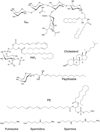Making the cut: the chemical biology of cytokinesis
- PMID: 20014865
- PMCID: PMC2807474
- DOI: 10.1021/cb900256m
Making the cut: the chemical biology of cytokinesis
Abstract
Cytokinesis is the last step in the cell cycle, where daughter cells finally separate. It is precisely regulated in both time and space to ensure that each daughter cell receives an equal share of DNA and other cellular materials. Chemical biology approaches have been used very successfully to study the mechanism of cytokinesis. In this review, we discuss the use of small molecule probes to perturb cytokinesis, as well as the role naturally occurring small molecule metabolites such as lipids play during cytokinesis.
Figures



 (red) were stained with anti-tubulin (Sigma T6199),
(red) were stained with anti-tubulin (Sigma T6199),  (green) was stained with Phospho-Myosin Light Chain 2 (Ser19) antibody (Cell Signalling, 3671L),
(green) was stained with Phospho-Myosin Light Chain 2 (Ser19) antibody (Cell Signalling, 3671L),  (blue) with DAPI. Scalebar represents 10 µM.
(blue) with DAPI. Scalebar represents 10 µM.

 (vector kindly provided by Tamas Balla, NIH).
(vector kindly provided by Tamas Balla, NIH).  (red) were stained with anti-tubulin (Sigma T6199),
(red) were stained with anti-tubulin (Sigma T6199),  (blue) with DAPI. Scalebar represents 10 µM.
(blue) with DAPI. Scalebar represents 10 µM.References
-
- Eggert US, Mitchison TJ, Field CM. ANIMAL CYTOKINESIS: From Parts List to Mechanisms. Annu Rev Biochem. 2006;75:543–566. - PubMed
-
- D'Avino PP, Savoian MS, Glover DM. Cleavage furrow formation and ingression during animal cytokinesis: a microtubule legacy. J Cell Sci. 2005;118:1549–1558. - PubMed
-
- Glotzer M. The molecular requirements for cytokinesis. Science. 2005;307:1735–1739. - PubMed
-
- Maddox AS, Oegema K. Deconstructing cytokinesis. Nat Cell Biol. 2003;5:773–776. - PubMed
Publication types
MeSH terms
Grants and funding
LinkOut - more resources
Full Text Sources

